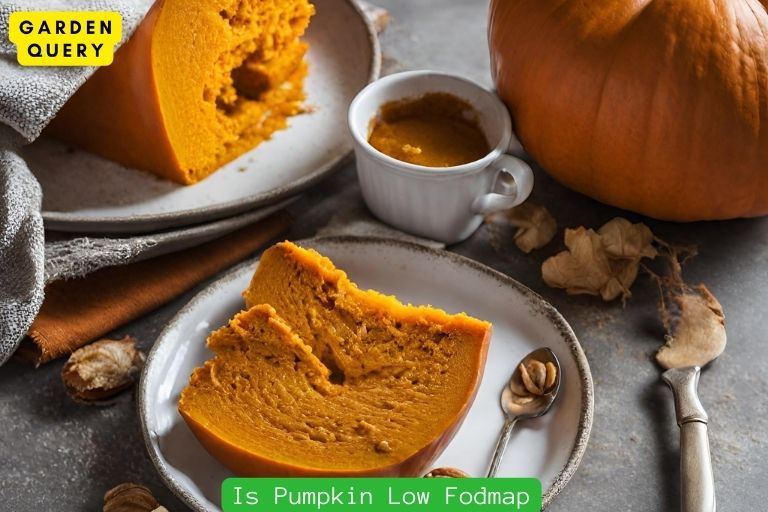Is Pumpkin Low Fodmap? Secret Revealed!
Understanding the Low FODMAP Diet
The Low FODMAP diet is a relatively new approach to managing digestive issues and improving gut health. FODMAPs, which stands for Fermentable Oligosaccharides, Disaccharides, Monosaccharides, and Polyols, are a group of carbohydrates that may cause digestive symptoms in some individuals, especially those with irritable bowel syndrome (IBS).
The goal of the Low FODMAP diet is to limit the intake of these types of carbohydrates to reduce symptoms such as bloating, gas, abdominal pain, and diarrhea. Foods that are high in FODMAPs include certain fruits, vegetables, dairy products, grains, and sweeteners.

Now, you might be wondering if pumpkin is low FODMAP. The answer is, it depends. Pumpkin can be low FODMAP, but it can also be high in FODMAPs depending on how it is prepared and consumed.
Fresh pumpkin, as well as canned pumpkin puree, is generally considered low FODMAP in small to moderate serving sizes. However, pumpkin products that contain added ingredients, such as pumpkin pie filling or pumpkin spice blends, may contain high FODMAP ingredients like sweeteners or spices that can trigger symptoms in some individuals.
It’s important to read food labels and look for any high FODMAP ingredients before consuming pumpkin products. Additionally, it’s recommended to start with a small serving size and monitor your symptoms to see if pumpkin triggers any digestive discomfort.
If you find that pumpkin is causing symptoms or you are unsure about its FODMAP content, it may be helpful to consult with a registered dietitian who specializes in the Low FODMAP diet. They can provide personalized guidance and help you navigate the diet effectively.
Remember, the Low FODMAP diet is not meant to be a long-term solution but rather a short-term elimination diet to identify specific triggers and determine individual tolerance levels. Once your symptoms are under control, foods can be reintroduced gradually to identify your personal FODMAP thresholds.
In conclusion, pumpkin can be low FODMAP in certain forms and serving sizes. It’s important to be mindful of added ingredients in pumpkin products and start with small portions to assess your tolerance. Consulting with a registered dietitian can provide valuable support and guidance on the Low FODMAP diet.
FODMAP Content in Pumpkin
When following a low FODMAP diet, it’s important to understand the FODMAP content of different foods, including pumpkin. Pumpkin is generally considered to be low in FODMAPs, making it a suitable choice for those on a restricted diet.
Pumpkin is a type of winter squash that is rich in nutrients such as vitamin A, vitamin C, and potassium. It is also a good source of fiber, which can help promote digestive health. However, some individuals with sensitive digestive systems may experience symptoms when consuming high FODMAP foods.
According to Monash University, a leading authority on the low FODMAP diet, small servings of pumpkin are considered to be low in FODMAPs. This means that most people should be able to tolerate pumpkin without experiencing symptoms such as bloating, gas, or diarrhea.
It’s worth noting that different parts of the pumpkin can have varying FODMAP content. The flesh of pumpkin is generally well-tolerated, but the seeds and skin can be higher in FODMAPs. If you’re unsure about the FODMAP content of a specific pumpkin dish or recipe, it’s always a good idea to consult a registered dietitian or refer to a reputable FODMAP food list.
When incorporating pumpkin into your low FODMAP diet, it’s important to pay attention to portion sizes. While small servings of pumpkin are generally well-tolerated, consuming large amounts may increase the FODMAP load and potentially trigger symptoms in sensitive individuals. Moderation is key when it comes to maintaining a balanced low FODMAP diet.
In conclusion, pumpkin is considered to be low in FODMAPs, making it a suitable choice for individuals following a low FODMAP diet. However, it’s important to be mindful of portion sizes and listen to your body’s individual tolerance levels. As always, consulting with a healthcare professional or registered dietitian can provide personalized guidance and support when navigating a low FODMAP lifestyle.
Pumpkin and Digestive Health
When it comes to digestive health and the low FODMAP diet, many people wonder whether pumpkin is a suitable choice. Let’s explore the relationship between pumpkin and digestive health.
Pumpkin is generally considered to be low in FODMAPs (fermentable oligosaccharides, disaccharides, monosaccharides, and polyols), which are types of carbohydrates that can cause digestive issues in some individuals. However, it’s important to keep in mind that the FODMAP content of pumpkin can vary depending on the ripeness and preparation method.
According to Monash University, a trusted source for FODMAP information, both butternut and Japanese pumpkin are low FODMAP in small to moderate servings. This means that pumpkin can be a suitable choice for individuals following a low FODMAP diet.
Pumpkin is also rich in fiber, which is beneficial for digestion. It can help promote regular bowel movements and support a healthy gut. The fiber in pumpkin can also contribute to feelings of fullness and aid in weight management.
Additionally, pumpkin contains important nutrients such as vitamins A, C, and E, as well as potassium and magnesium, which all contribute to overall health and wellbeing.
However, it’s worth noting that some individuals may still experience digestive discomfort even with low FODMAP foods like pumpkin. Every person’s tolerance to different foods can vary, so it’s important to pay attention to your own body’s response.
If you’re unsure about whether pumpkin is suitable for your individual digestive needs, it’s a good idea to consult with a registered dietitian or healthcare professional who specializes in digestive health. They can provide personalized guidance and help you determine the best choices for your specific situation.
In conclusion, pumpkin is generally considered to be low FODMAP and can be a suitable choice for individuals following a low FODMAP diet. It’s rich in fiber and important nutrients, making it beneficial for digestive health. However, it’s important to listen to your body and consult with a healthcare professional if you have any concerns or specific dietary needs.
Preparing Low FODMAP Pumpkin Dishes
When it comes to cooking with pumpkin on a low FODMAP diet, there are a few things to consider. Pumpkin is generally considered to be low FODMAP, but it’s important to note that different types of pumpkin may have varying levels of FODMAPs.
To ensure you’re selecting a low FODMAP pumpkin, choose the common varieties such as butternut, Kent, or Queensland blue. These types are less likely to cause digestive issues for those following a low FODMAP diet.
Now, let’s explore a few delicious and low FODMAP pumpkin dishes you can prepare:
- Roasted Pumpkin Salad: Toss some diced pumpkin with olive oil, salt, and pepper, then roast it in the oven until tender. Mix the roasted pumpkin with baby spinach, crumbled feta cheese, and a sprinkle of pine nuts. Drizzle with a low FODMAP dressing for a refreshing and flavorful salad.
- Pumpkin Soup: In a large pot, sauté some leek greens or the green part of spring onions in oil until soft. Add diced pumpkin, low FODMAP vegetable broth, and a pinch of your favorite herbs and spices. Simmer until the pumpkin is cooked through, then blend until smooth. Top with a dollop of lactose-free yogurt for extra creaminess.
- Pumpkin risotto: Cook Arborio rice in a mixture of low FODMAP vegetable broth and white wine. In a separate pan, sauté diced pumpkin with garlic-infused oil and a pinch of thyme. Once the rice is cooked, stir in the cooked pumpkin, some Parmesan cheese, and season with salt and pepper. Serve warm for a comforting and hearty meal.
- Pumpkin Muffins: For a sweet treat, try making low FODMAP pumpkin muffins. Use gluten-free flour, lactose-free milk, and a low FODMAP sweetener such as maple syrup. Add in some pumpkin puree, cinnamon, and nutmeg for that classic pumpkin spice flavor. Bake until golden brown and enjoy as a snack or dessert.
Remember, while pumpkin is generally low FODMAP, it’s important to be cautious with portions. Stick to the recommended serving sizes and be mindful of other ingredients you may be using in your recipes. If you’re unsure, it’s always best to consult with a registered dietitian who specializes in the low FODMAP diet.
By taking the time to prepare low FODMAP pumpkin dishes, you can still enjoy the flavors of fall while keeping your digestive system happy and healthy. Get creative in the kitchen with these recipes and discover just how delicious low FODMAP eating can be.
Conclusion
In conclusion, the question of whether pumpkin is low FODMAP or not is a complex one. While pumpkin itself is considered low FODMAP, it’s important to be mindful of portion sizes and preparation methods when incorporating it into a low FODMAP diet. Pumpkin in small to moderate amounts can generally be well-tolerated by individuals with digestive sensitivities.
It’s also important to note that not all pumpkin-based products or recipes are considered low FODMAP. Some processed or prepackaged pumpkin products may contain high FODMAP ingredients or additives, so it’s essential to read labels and ingredients lists carefully.
If you’re following a low FODMAP diet and want to enjoy pumpkin, it’s recommended to consume fresh pumpkin in its natural form. Roasting or steaming pumpkin can help make it more easily digestible.
Remember, everyone’s tolerance to FODMAPs varies, so it’s important to listen to your body and work with a healthcare professional or registered dietitian who specializes in digestive health if you have any concerns or questions about including pumpkin in your diet.
Incorporating pumpkin into your low FODMAP diet can provide a delicious and nutritious addition to your meals. Whether it’s in soups, salads, or baked goods, pumpkin can add flavor, texture, and nutritional benefits. Just be mindful of portion sizes and preparation methods to ensure optimal digestion and minimize potential digestive discomfort.
So go ahead and enjoy the natural sweetness and versatility of pumpkin while being mindful of your individual tolerance and preferences. As with any dietary changes, it’s always best to consult with a healthcare professional to personalize your diet and ensure it meets your specific needs.
- Best Therapists In Dallas - February 1, 2024
- Holly Willoughby Husband: Holly Willoughby’s Love Story - January 30, 2024
- Holly Willoughby Dress: 5 Style Secrets and 7 Must-Know Career Milestones - January 30, 2024





